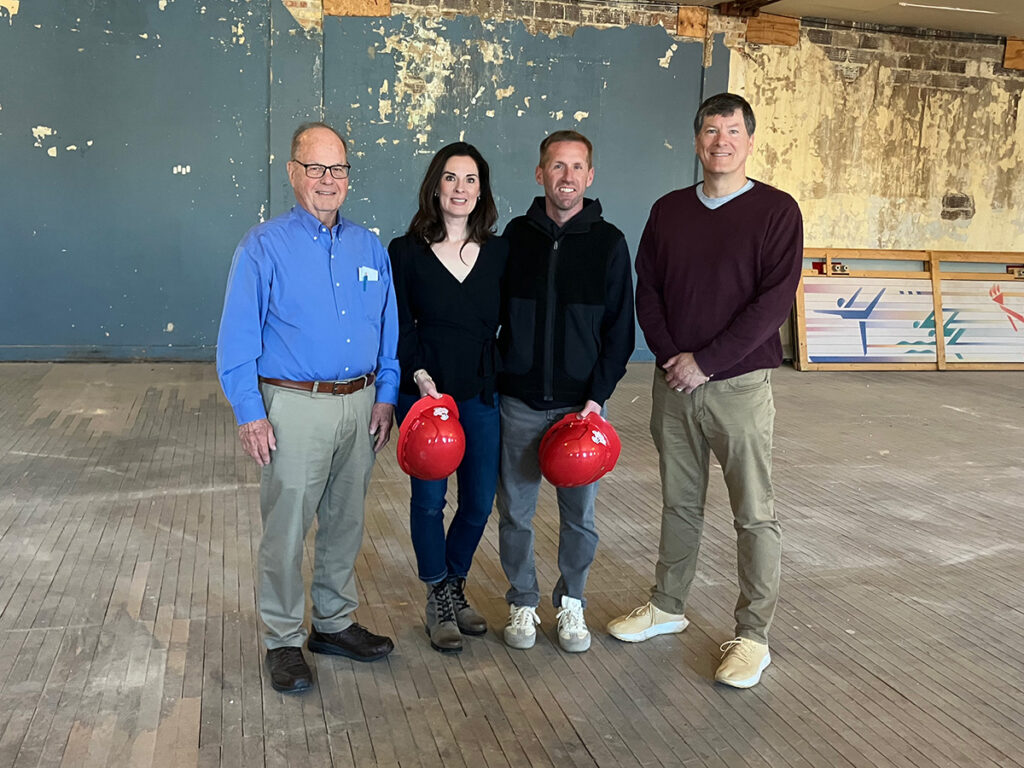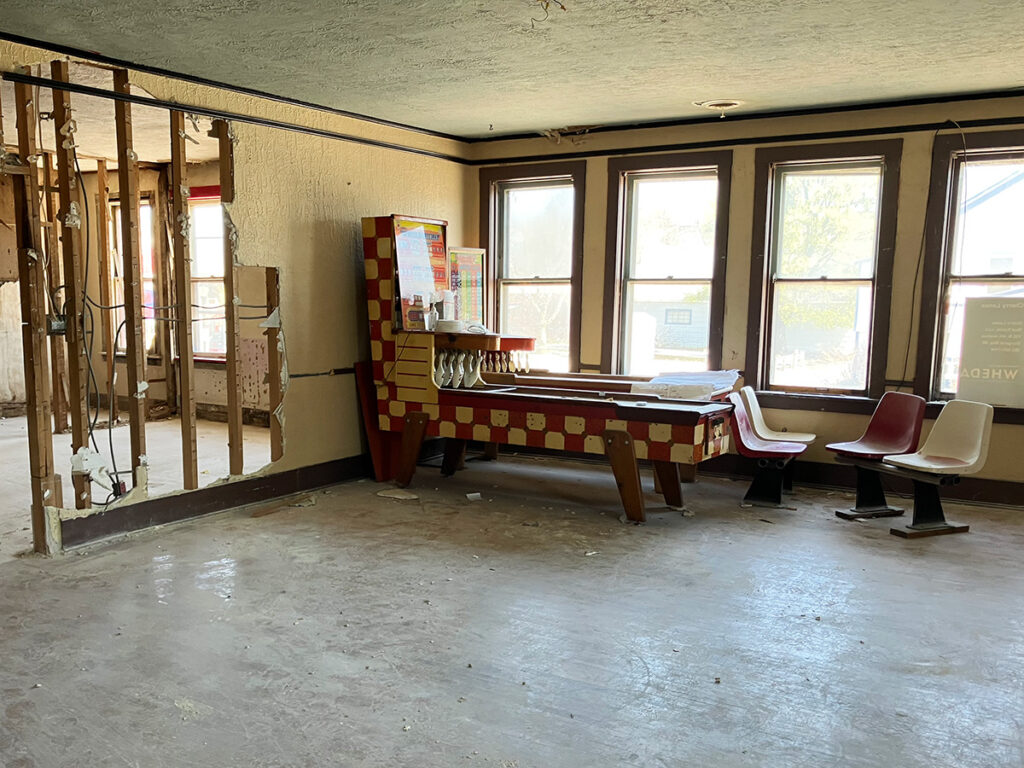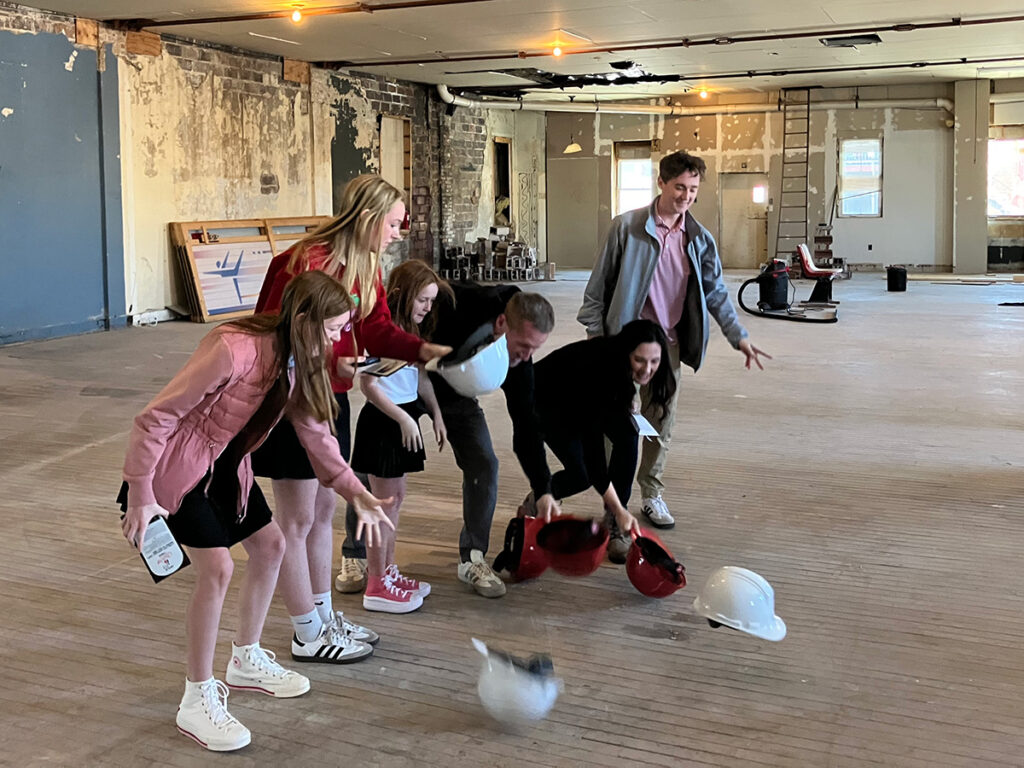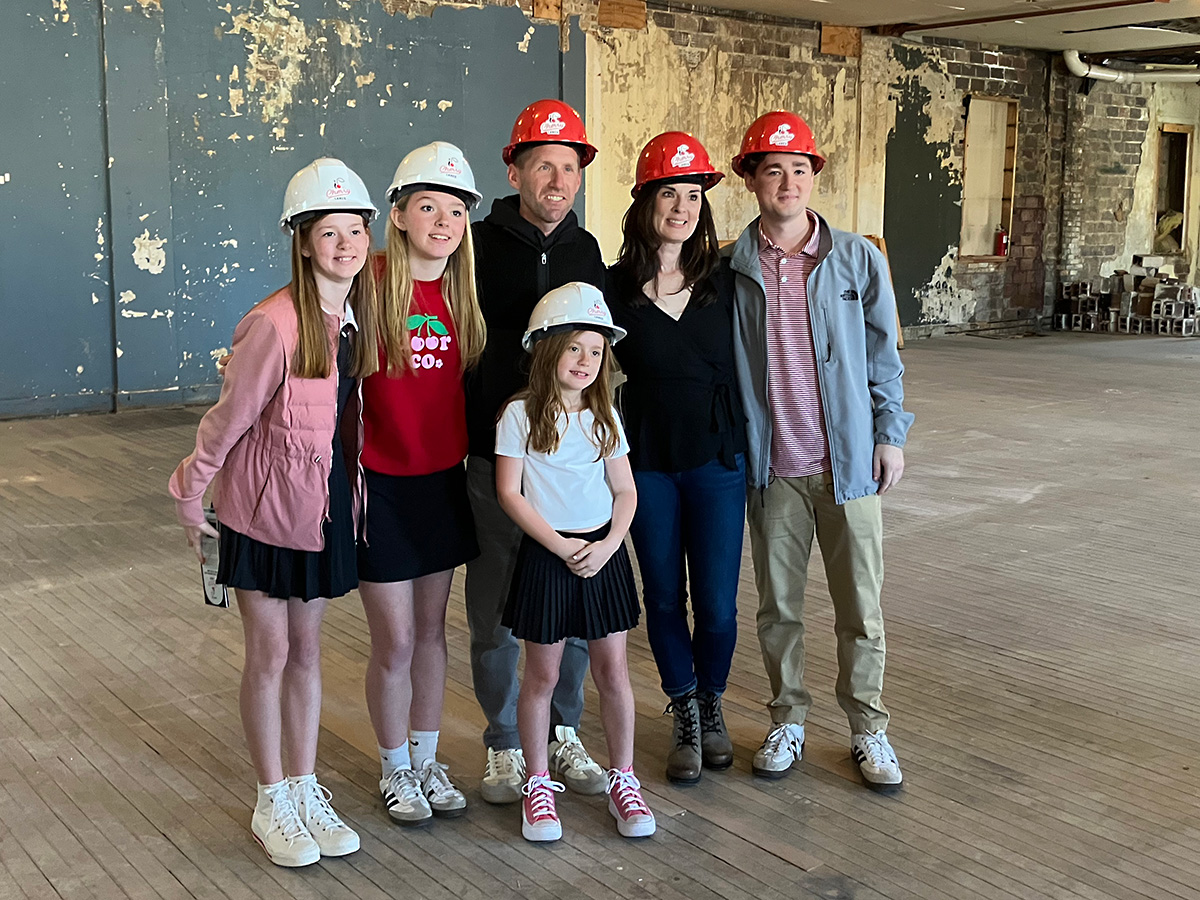Locked Out: Door County’s affordable housing shortage
Door County Knock is reporting an in-depth series on Door County’s affordable housing shortage, addressing questions such as why the county lacks affordable housing, how market trends have contributed to its decreased availability and what roadblocks exist to building more. Click here to read more.
If there are questions you’d like the answers to or people you’d recommend we talk with as part of our reporting, please email us at [email protected].
Over the past year and a half, Moira and Justin Callan have been trying to bring their vision of affordable workforce housing in Door County from idea to reality. Or at least to an active building site.
On May 9, the Lofts at Cherry Lanes, located at 135 N. 4th Ave. in Sturgeon Bay, was the site of a “hard hat throwdown” celebration to kick off the construction phase of the project. The Callans, who own Callan Properties LLC and Cherry Lanes Real Estate, own dozens of affordable housing units in northeastern Wisconsin, and this is their first development in Door County. Several community members and individuals involved with the project, including Sturgeon Bay Mayor David Ward and the Callans’ four children, attended the event.
In 2024, the Callans purchased the 100-year-old building that houses Cherry Lanes Arcade Bar on the ground level and a 7,500 square foot ballroom above. With affordable housing in mind, the couple is converting the ballroom space into eight rental units, including five one-bedroom and three studio apartments.
The $650,000 construction project is being financed by a $160,000 loan from the Wisconsin Housing and Economic Development Authority, $250,000 from Door County’s Workforce Housing Lending Corporation, and $240,000 from a private bank loan.
WHEDA and WHLC requirements ensure the units will remain affordable long-term at $800 to $950 per month. Affordable housing is defined as when housing costs, including utilities, do not exceed 30 percent of total income in a household. The Lofts will be reserved for Sturgeon Bay residents whose income is at or below 80 percent of the area median income, according to the Callans.
The U.S. Department of Housing and Urban Development uses a formula to determine income limits for affordable housing based on the area median income. The formula also takes into account family size. For Door County in 2025, the income limits based on 80 percent of the area median income are $56,500 for one person or $64,550 for two people, for example.
The Lofts are an attempted response to Door County’s affordable housing needs, according to the Callans, needs that are in line with an ongoing nationwide shortage.
Any media coverage of Door County’s part of that shortage in the last several years likely mentions a 2019 housing study commissioned by the Door County Economic Development Corporation, local businesses and local governments. The study, conducted by consulting firm AECOM, quantified Door County’s need for affordable housing and acted as a launchpad for various initiatives to help solve the problem.
According to the study, 1,070 affordable housing units were deemed necessary to meet needs at the time it was conducted. There has not been an update to the study, and local agencies and municipalities have been working on the problem. But it is safe to say there have not been that many affordable units added to local housing stock since 2019.
A number of factors are involved in why Door County does not have enough affordable housing. Some of them are universal issues felt nationwide, such as high interest rates, rising inflation for building materials and a shortage of construction industry workers. Other issues are more specific to Door County’s geographical and socioeconomic character. They include long-standing shortages of rental units and housing for seasonal workers, a second-home market that drives up costs, increased tourism and short-term rental units, building and zoning requirements and a lack of public sewer or water in many areas.
Since the 2019 study, Door County has undertaken a number of initiatives to combat the crisis. The Door County Housing Partnership was formed, the use of tax incremental financing districts and subsidies to housing developers has increased, the county Land Use Services Department has made some changes to zoning and building requirements, and there has been more investment in affordable housing from the state and federal government, as well.
Hurdles remain, but the Callans’ development, and the loans and local officials supporting it, represent one example of an attempt to overcome those hurdles and make progress toward addressing the county’s affordable housing shortage.
Door County Knock in the coming months will be reporting a series of stories on affordable housing. The series will address the factors involved in the county’s shortage of affordable housing, as well as possible paths forward. This story is the first in that series.
Public loans, private financing, bowling games and beer sales
The Lofts at Cherry Lanes are also a unique collaboration. The Callans worked with the City of Sturgeon Bay and WHEDA to get the project off the ground. This project was different than other developments the couple has worked on, starting from the beginning. Moira Callan said it was the first time she got curious about public incentives for affordable housing development.
“When I originally started this project, I was really intrigued by municipalities, as well as the state of Wisconsin and the federal government (and) what they provided for this overall need of affordable housing,” she said. “So this was my own kind of investigative work.”
She discovered that if a vision aligns with a community’s needs and goals, officials are happy to help and clear some boundaries. Moira’s investigation also led the Callans to the WHEDA Restore Main Street loan program.
One requirement for the WHEDA loan is for the municipality to be willing to make changes to reduce housing development costs. The City of Sturgeon Bay changed its zoning to allow for studio units at about the same time the Callans purchased the Cherry Lanes property, Moira said, allowing them to use that in the WHEDA loan application.

Restore Main Street loans are designed to increase the supply of affordable workforce apartments by revitalizing vacant or underutilized space located one or two levels above ground-floor commercial spaces. The units must remain affordable for at least 10 years. $100 million in funding has been allocated to the loan program, and recipients can receive a maximum of $20,000 per unit or 25 percent of the total housing rehabilitation costs, whichever is less. The Callans’ project was awarded $160,000.
Thirty percent of the WHEDA loan funds are set aside for municipalities with a population of less than 10,000, and the interest rate is only 1 percent for those loans, versus 3 percent for municipalities with more than 10,000 people. The City of Sturgeon Bay is poised to cross that population threshold by the next census in 2030.
Moira’s research and collaboration with municipal leaders like Marty Olejniczak, Sturgeon Bay’s community development director, also led her to the Door County Workforce Housing Lending Corporation, a nonprofit launched in 2023. WHLC is jointly governed by the Door County Community Foundation and NeighborWorks Green Bay. (Disclosure: Knock has received funding in the past through a Community Foundation grant program. Donors have no editorial control over Knock.)
WHLC can provide up to $500,000 in loans for a housing project that must have at least 20 percent of the units set aside for households earning less than 80 percent of the median income. Tenants must also be year-round residents, and leases will be for 12 months. The units have to remain rented under these guidelines for at least 20 years, according to the terms of the loan.
The Callans received $250,000 from WHLC. The rest of the construction funds, after the WHEDA and WHLC loans, come from a private bank loan with Bank First, Moira said, and the arcade bar provides a steady stream of income to put back into the project.
“We’re not bar owners or bar goers,” Moira said, but they purchased it with the understanding that any profit would go toward construction.
“That’s what helps keep the cost of it affordable,” she said. “Because building affordable housing is not affordable.”
Adapt and overcome
“Seeing the vision was the easy part. It’s now getting through permitting, where the rubber really meets the road, is where the unknowns pop up,” Moira said. Though design considerations for getting a 100-year-old building up to 2025 standards has added cost to the project and has sometimes been complicated, these are things the couple would have needed to address no matter if they were renovating or building from scratch, she added.
The ground-level business has been a bowling alley since it was built in 1929. It was renovated in 2018 by previous owners Erin and Kevin Bosman, who exposed the original brick walls and terrazzo floors. That renovation included an arcade game space. Upstairs, the ballroom has been used for many different activities, including a dance hall and a boxing club, but it has sat mostly vacant and unused for decades.
Besides changing zoning to allow for studio units and supporting the Callans’ loan applications, the city’s Transportation Board made a recommendation that parking fees be lowered to $0 for the development. The matter is still under consideration by the Common Council and Community Protection and Services Committee.
As part of the normal permitting process, the city requires 1.5 parking spots per one-bedroom or studio apartment. Land is limited in the area, so the Callans requested use of city parking lots. The city reviews these requests and charges a fee per space on a case-by-case basis.
Building a parking lot with 12 spaces would cost the Callans at least $17,671.08, based on 2024 construction costs, according to the city’s Senior Engineering Technician Brian Spetz.
Eliminating more construction costs and waiving city parking costs should be “considered economic support for redevelopment and revitalization efforts in the downtown area, something the city has worked to promote,” according to the Transportation Board’s recommendation.
Another curveball for the Callans was the need for a sprinkler system. International Building Code, which has been adopted by the state of Wisconsin, requires one for any multi-unit housing with three or more attached units. The piping that goes into the building is very old and does not have the water pressure for a sprinkler system, so “we basically have to rip up 4th Avenue,” Moira said.
The project also requires an elevator in line with accessibility requirements. The plumbing and elevator costs added about $125,000 to the project, according to the Callans.
Natural light and window placement was a challenge when it came to designing the floor plans of the units, Moira said. The space adjoins another building, leaving one whole side of the ballroom with no exterior walls.
“I couldn’t get creative with skylights,” she said, because of the required sprinkler system taking up ceiling space. This is where the concept of studio apartments was really helpful, she said, to meet a Wisconsin building code requirement regarding natural light. Windows allowing natural light must have a combined surface area that is at least eight percent of the total square footage, she explained.
It is not just about meeting codes, however, according to the Callans. One of their goals for all their projects is to create affordable housing that is “a space people want to live in,” Moira said. Design considerations for the Lofts ensure the living spaces are secure and soundproof to the bowling pins and bar noise below.
Who will be living there remains to be seen, Moira said, but her initial research suggested single individuals working in the shipbuilding industry or members of the Coast Guard were the potential target market. The space lends itself well to workers who may be in transition, Moira said, where they can live for a few years until they have a family or their needs grow.
Supporting Sturgeon Bay’s industry and need for teachers, nurses and other workers by providing affordable housing is another part of the Callans’ development vision, she added.
The couple has a waitlist of 38 people interested in the units when they become available next year, Moira said.

The Callans hope their project will make an impact beyond the lives of future tenants and that more mixed-use developments like theirs will add to greater economic and cultural gains in Sturgeon Bay. The Lofts at Cherry Lanes is the first development in Sturgeon Bay to be supported by the WHEDA Restore Main Street loan program.
“I’ve seen in other communities how people living in downtown areas added to the shops, to the local attachment to the area,” Moira said.
Background and legacy
The Callans have been seeing the impact of affordable workforce housing in small downtowns and communities for more than a decade. Callan Properties owns and self-manages 56 units around northeastern Wisconsin, and the recently formed Cherry Lanes Real Estate will do the same for the Sturgeon Bay project.
Justin works in banking and Moira has a full-time job in marketing. Her marketing skills are evident when she uses the term “untapped potential” to describe the driving factor behind their property investments and development.
“How do you get more bang out of an existing building?” she said.
The Callans started their real estate journey by flipping their own single-family home several years ago. It was a good learning experience, Moira said, and showed them that they wanted to have more reach and more diversified investments than what providing one home for one family could bring. So they sold that house and purchased a four-unit multi-family building in Shawano that had an unused, “mostly demolished” fifth unit. The couple renovated the fifth unit and rented them all.
Another example of finding “untapped potential” was a building in Green Bay with four very large one-bedroom units, Moira said. The Callans turned them all into two-bedrooms, which improved the rental clientele and lowered the cost of living for that area, she said.
The Callans said they try to focus primarily on buying properties in communities with less than 10,000 people because those areas have such a “critical need.” However, an eight-unit building in Suring, Wis., which has a population of only 545 people, felt like a risk, Moira said.
Turns out, the Suring property was the easiest one for the Callans to fill.
“We have a waiting list with farmers for their staff, the school for educators,” she said. “Suring was really where workforce housing became centered in my mind.”
The Callans’ development strategy consists of a combination of multiple factors, Moira said: affordable, workforce housing in existing properties with untapped potential.
When the Callans brought their strategy closer to Door County, they looked at a couple of options including a convent in Algoma and an abandoned hospital turned seasonal haunted house in New London.

At the time they were looking for property, the Callans were not aware of the WHEDA and WHLC loan options. Paying out of their own pocket for the building and renovation stopped them from moving forward on those other properties, Moira said, but Cherry Lanes’ arcade bar was the perfect solution: a space to develop affordable housing “from scratch” in a community that needed it, with a profitable business that could help sustain the project.
The Callans rely on arcade bar staff and their college-age son to run the business part of Cherry Lanes, and Moira said they think the arcade bar and bowling alley is unique and lends itself well to being a community space.
Acknowledging that eight units is a small contribution to affordable housing stock in Door County, the Callans said there are other buildings in downtown Sturgeon Bay with similar untapped potential.
“If we were just inspiring somebody else to take on something of similar scope and have a compounding effect, I think that would be, that would be a great legacy,” Moira said.

